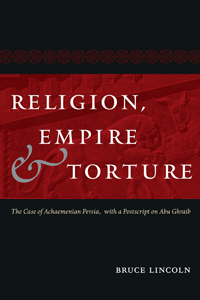Lincoln connects Achaemenian Persia to events at Abu Ghraib
By Josh SchonwaldNews Office
 | |
When Bruce Lincoln, the Caroline E. Haskell Professor of History of Religions in the Divinity School, was completing his most recent book Religion, Empire & Torture, he grappled with a tricky question.
Writing about the role of religion in empire building in Achaemenian Persia, he wanted to draw explicit connections between historical content and contemporary events in post-script.
Some peers suggested that this method of making connections between the Persian Empire and the accounts of violence at the Abu Ghraib prison in Baghdad in 2004 might undermine the book. Some colleagues argued that serious specialist scholars might see him as controlled by current events, transparently critical of George W. Bush, and, hence, they would not take the work as serious historical scholarship.
Lincoln went ahead with his Abu Ghraib post-script, and earlier this month, Religion, Empire & Torture, published by the University Press, received the Frank Moore Cross Award for 2007 from the American Schools for Oriental Research. The award honors the editor or author of the most substantial volume related to ancient Near Eastern and eastern Mediterranean epigraphy, text and/or tradition.
In the citation for the award, the ASOR credited Lincoln for his reading of texts from the Persian Empire relating to imperial theology, and specifically commended him for including the post-script, writing: “At the end of his study, he brings us back to the present with his fascinating analysis of the photographs from Abu Ghraib in the context of the Achaemenian case studies presented in the first part of the book.”
“It’s tremendously gratifying,” Lincoln said of the honor. “I’m a generalist and a comparativist. To get this type of confirmation from a group of specialists, a group who I don’t ordinarily work with, like the ASOR, is a great honor.”
Richard Rosengarten, Dean of the Divinity School, praised Lincoln as a remarkable scholar with a unique ability to communicate his research to very different audiences. “With this prestigious award, the ASOR highlights his remarkable capacity to engage, in the same volume, both specialists in a particular field of research and all scholars who think about the broadest and most important questions in humane learning,” said Rosengarten. “This is a signal achievement, unsurprising to those of us who know his work but no less gratifying because of that.”
Though Lincoln studied Achaemenian Persia extensively earlier in his career and has a working knowledge of old Iranian languages, such as Old Persian, Pahlavi and Avestan, his new book was very much a return for him. A comparativist, he is famously eclectic in his interests. He concentrates on pre-Christian Europe and pre-Islamic Iran, but he also has written about everything from Lakota sun dances and Swazi kingship to Melanesian funerary rituals. In recent years, though, Lincoln has focused heavily on contemporary issues in his work.
Following the completion of Holy Terrors: Thinking about Religion after 9/11— which examined the Sept. 11 terrorist attacks and Americans’ understanding of religion—Lincoln became interested in earlier examples of the role religion has played in empire building.
What prompted Lincoln to revisit Persia and the little-studied case of Achaemenian Persia was an invitation from French scholar Jean Kellens to give a series of lectures at the College de France. As Lincoln prepared for his lectures, studying texts from the Persian Empire, he began to find evidence of just how powerful a role religious ideas played in creating one of the world’s largest empires.
“The Persians assembled a spectacular expanse of territory; they ruled all of Asia for two centuries,” said Lincoln. “The book is about the way that they justified empire building.” In the book, Lincoln identified three pieces of the Persian imperial theology: dualistic ethics, a theory of divine election and a clear path to salvation.
A crucial piece of building the Persian Empire, for instance, Lincoln said, was the divine mission to restore paradise. In the chapter titled “The Dark Side of Paradise,” Lincoln shows how the Persians’ religiously justified mission to restore paradise resulted in the creation of fabulous walled gardens, but also justified unimaginable violence, destruction and torture.
In the post-script, Lincoln shifts to the present, using photographs from the torture at Abu Ghraib to draw haunting parallels to Achaemenians. Of the decision to include the post-script, Lincoln said, “I wanted it to be explicit. I wanted to show how what happened two millennia ago was directly applicable to what’s happening now. And what happened is also applicable to Ancient Rome, the Ottomans, the Hapsburgs …”
Now Lincoln is turning his interest to another example of the role religion played in empire building, by examining 13th-century texts in Old Norse that describe events that occurred in 9th-century Norway. In this case, Lincoln said, he is looking at how mythological narratives justified violence and empire building in medieval Norway.
In addition to the Frank Moore Cross Award, Lincoln has received many other honors, including the 2002 Gordon J. Laing Prize from the University Press for his book, Theorizing Myth: Narrative, Ideology, and Scholarship.
![[Chronicle]](/images/sidebar_header_oct06.gif)